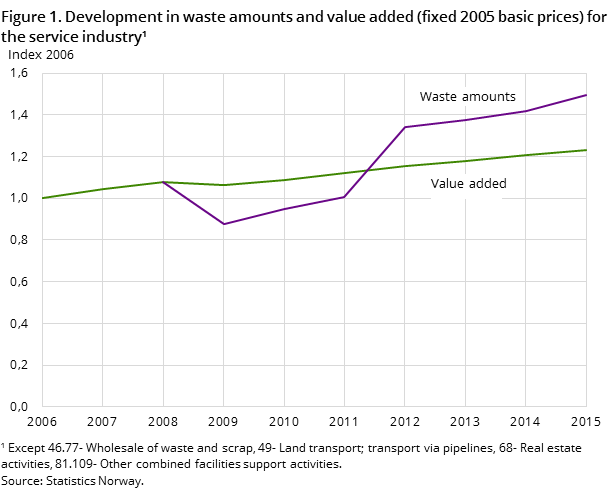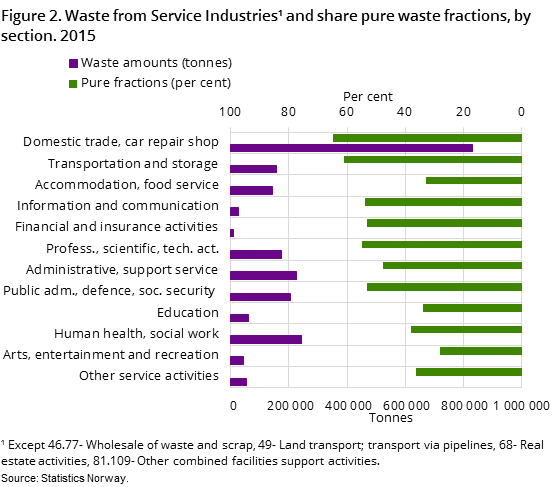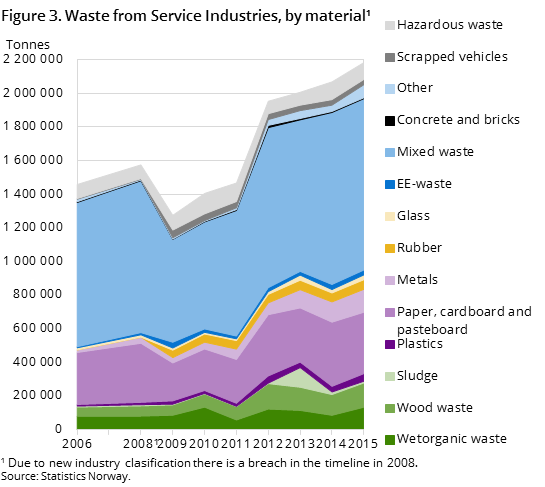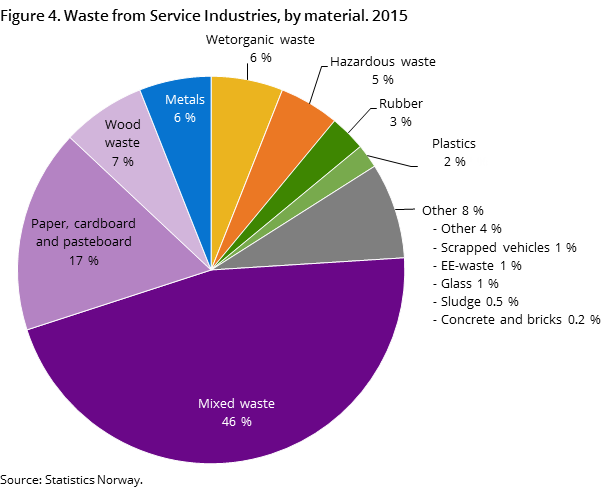Content
Published:
This is an archived release.
Service industry waste steadily increasing
The service industries generated just short of 2.2 million tonnes of waste in 2015. As before, the domestic trade business had the highest share of the waste, with 38 per cent.
| Tonnes | Per cent | Per cent | ||
|---|---|---|---|---|
| 2015 | 2014 - 2015 | 2008 - 2015 | ||
| Waste amounts by material | ||||
| In total | 2 184 126 | 100.0 | 5.5 | 38.6 |
| Mixed waste | 1 019 654 | 46.7 | -0.3 | 12.9 |
| Paper, cardboard and pasteboard | 365 363 | 16.7 | -4.4 | 4.0 |
| Wetorganic waste | 133 697 | 6.1 | 56.1 | 65.6 |
| Hazardous waste | 100 630 | 4.6 | -4.6 | 22.3 |
| Other materials | 564 782 | 25.9 | 19.1 | 257.5 |
| Waste by section | ||||
| In total | 2 184 126 | 100.0 | 5.5 | 38.6 |
| Wholesale and retail trade: repair of motor vehicles and motorcycles | 830 034 | 38.0 | -3.5 | 29.2 |
| Human health and social work activities | 242 896 | 11.1 | 9.1 | 21.4 |
| Administrative and support service activities | 226 908 | 10.4 | 13.2 | 33.8 |
| Other service sections | 884 288 | 40.5 | 12.4 | 57.0 |




The waste amounts from the service industries increased by more than five per cent from 2014 to 2015. Mixed waste is still the largest waste fraction, with 47 per cent of the total waste.
The waste amounts from the service industries have increased by 50 per cent since 2006. In comparison, the value added (fixed 2005 basic prices) for the industry increased by only 23 per cent during the same period. This implies that the industry has become less waste efficient during the last eight years.
Most waste from the domestic trade business
More than 830 000 tonnes of waste, or 38 per cent, came from the domestic trade business in 2015. Second and third in magnitude are human health and administrative and support service activities, with 11 and 10 per cent of the total waste amounts respectively.
Increase in other materials, decrease in sludge
Several waste fractions increased from 2014 to 2015, including “Other materials”, which covers, for example, bricks, gypsum, ceramics and medical waste. The increase was 107 per cent from 2014 to 2015. The second and third largest increases were for wet organic waste and glass waste.
Despite the general increase in waste amounts, some waste fractions have decreased. The largest decreases in terms of percentage were sludge followed by concrete and scrapped vehicles, with a reduction of 31, 18 and 5 per cent respectively.
Service industriesOpen and readClose
Service industries is a collective term that includes wholesale and retail trade, hotels and restaurants, transport, storage and communication, financial intermediation, real estate, renting and business activities, together with public and personal services. This corresponds to section G-U in the Standard Industrial Classification (SIC2007). For the time being, the statistics cover section G-S, except 46.77- wholesale of waste and scrap, 49- land transport; transport via pipelines, 68- real estate activities.
Uncertainty in the figuresOpen and readClose
The calculations are based on customer registers from a sample of waste collectors. Some of the customers probably delivered some pure waste fractions to waste collectors outside the sample, or to collectors outside the waste collection business. The total amount of waste and the amount of pure fractions may therefore be too low, while the share of mixed waste may be too high.
Contact
-
Camilla Skjerpen
E-mail: camilla.skjerpen@ssb.no
tel.: (+47) 48 22 72 14
-
Gisle Berge
E-mail: gisle.berge@ssb.no
tel.: (+47) 48 12 19 97
